What's happenedSUHDTVsSamsung.
This line first appeared in 2015 and was represented by the JS7200, JS8500, JS9000 and JS9500 series in our market.
A distinctive feature of these models was the support for HDR materials of the HDR10 standard, high peak brightness and wide color gamut for display more shades in 4k materials.
HDR TVs, when playing appropriate material, produce a brighter and more detailed picture in the bright areas of the scene, while at the same time more detail in the dark areas. At least that's how it's meant to be.
While there are certain synchronization problems - for example, when playing a 4k HDR disc with a UBD-K8500 Blu-ray, the high dynamic range mode may not turn on or lead to a significant deterioration in the image in terms of white balance and the number of displayed gradations. The output peak brightness is also not stable - repeating the reproduction of the same section of the scene, you can get both 800 and 1200 cd / m2.
Undoubtedly, in the next firmware, these playback nuances should be eliminated. When playing HDR materials online (Netflix), there are much fewer problems.
All SUHD TVs are automatically 4K TVs, that is, their matrix resolution is 3840x2160 pixels. Therefore, SUHD and SUHD 4K are one and the same. Both abbreviations are found on the Internet.
Model overview SUHD TVs Samsung 2016.
As in 2015, Samsung's SUHD TVs include several series. However, if last year the only flat SUHD TV for our market was the JS7200 with predominantly PLS and a mandatory 60 Hz matrix, then all new KS models have acquired 120 Hz matrices of the –VA family.
VA matrices have several times greater contrast, which makes it easier to view dark scenes in films, as well as to see more details in HDR materials. Minus -VA matrices - smaller viewing angles relative to IPS / PLS.
120Hz TVs improve dynamics processing by inserting additional frames and adjusting the backlight flicker rate – reducing twitching in fast scenes and improving overall clarity.
So, all new Samsung TV models of 2016 have the letter K in the article. SUHD models add S to it - 55KS7000. Ordinary 4k TVs instead of S received the letter U - 49KU6450. FullHD models have only one letter representing the year - K: 40K5500.
The 2015 models are still on sale, instead of K they have the letter J (65JS9500).
Like last year, it all started with a leapfrog in articles for different regions. By the middle of the year, everything more or less came to a common denominator.
Spy runs on sites in the US, Britain, Europe have revealed some consistency.
In the USA, the KS9800 series is the representative of the highest price segment in 65, 78 and 88 inches. The main difference is controlled carpet lighting, FALD. 600 LEDs divided into 150 zones. Each zone, depending on the scene, adjusts the brightness of the LEDs from minimum to maximum. Of the LCD TVs, it is these TVs that provide the maximum of positive emotions when viewing HDR and standard high-quality materials in any lighting conditions.
Next comes the KS9500 series, but with Edge backlighting. If earlier Samsung implemented such a backlight on both sides of the screen, now, like most Edge TVs, it is located below. Double-sided Edge allowed, when enabled in the menu, the corresponding function to turn off the LEDs at the top and bottom, where black bars from widescreen films are usually located. Thus, the picture was perceived more interesting and without possible microlights.
Of course, this feature in the new 2016 Samsung 4k TVs had to be abandoned in exchange for a thinner body. Bonus - the backlight has become more uniform, which is important when watching movies, especially in complete darkness.
KS9500 is presented in diagonals of 55, 65, 78 inches. Its flat counterpart is the KS9000. In diagonals 55 , 65 and, this time, 75 '.
Next come the same models, but in a slightly different case with the location of the legs along the edges - the KS8500 and KS8000 series. Curved and flat, respectively. KS8500 in three diagonals - 49, 55 and 65 inches. Flat variants of the KS8000 in four: 49, 55, 60 and 65.
Below series 8, there are no longer SUHD, but ordinary 4k KU7500 / KU7000 TVs with 60 Hz matrices.
Why all this description of American models? In the USA, the widest assortment list is one time. Secondly, many of the readers are in different regions or order equipment from other countries. Therefore, in order to understand exactly what you will get in the end, you need to be attentive to the indices.
Now let's find out how things are with 2016 Samsung SUHD TVs in our region.
The official website has only one version of the top FALD version - 88KS9800.
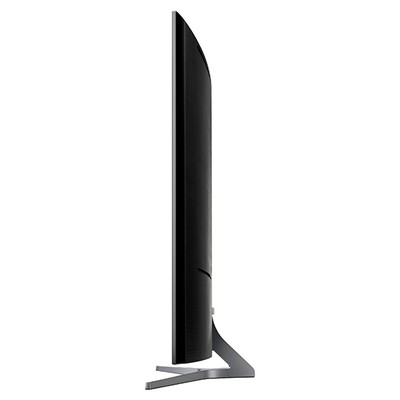
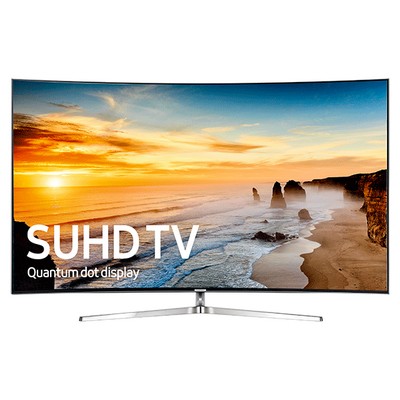
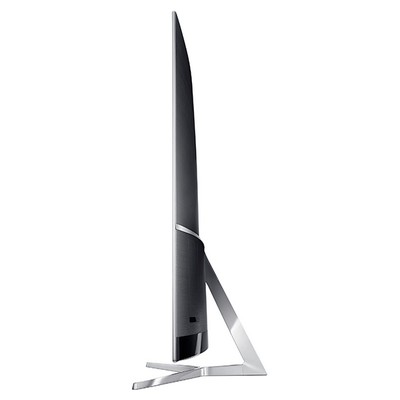
Its flat counterpart is the KS8000. Almost in the same diagonals - instead of 78 there are 75 (49KS8000, 55KS8000, 65KS8000, 75KS8000).


KS7500 is presented in diagonals 49, 55 and 65 (49KS7500, 55KS7500, 65KS7500),

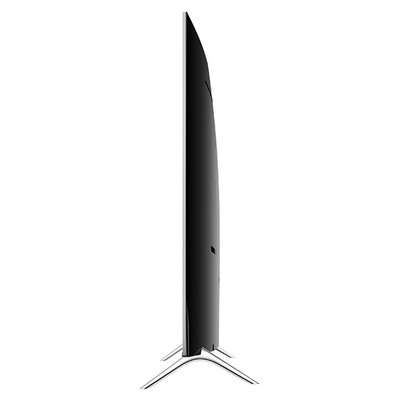
and KS7000 in 49, 55 and 60 (49KS7000, 55KS7000, 60KS7000).

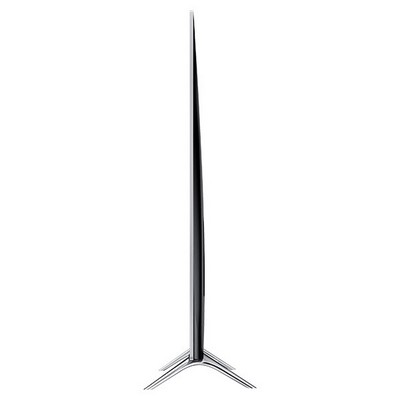
This is where our 2016 Samsung SUHD TVs end.
In Poland, FALD comes in two series - like ours, 88KS9800 and in 65 diagonal - 65KS9500. There are no FALD models on the official Finnish website yet, and the rest come with 5 at the end of the article - 60KS7005. If you order our models, make sure they are assembled in Kaluga.
The easiest way to recognize the FALD model is by the noticeably thicker case. The back cover in the top version does not have a horizontal strip, and the connectors are located in the middle part of the cover, and not in the bottom corner.
FALD KS9800 (for some KS9500):

Edge KS9000 (some have KS9500):
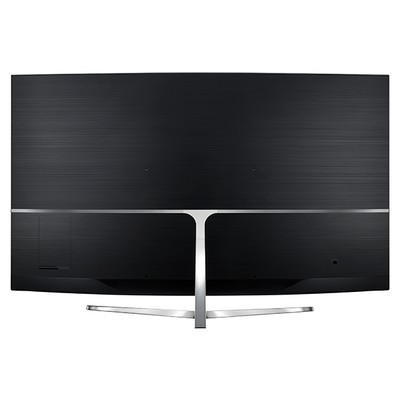
This year, Samsung again has non-standard wall mounts - the bushings are even more recessed into the case, and the lower ones are deeper than the upper ones (due to the curve of the screen and the design of the back cover). However, special plastic extension tubes are included in the kit, with the help of which the difference between the lower holes and the upper ones is leveled. Recommended screws are M8 45 - 50 mm.
VESA for wall mounting TVs:
88KS9800: 600x400, weight approx. 59 kg.
78KS9000: 600x400, weight approx. 44 kg.
65KS9000: 400x400, weight approx. 26 kg.
55KS9000: 400x400, weight approx. 18 kg.
49KS9000: 400x400, weight approx. 15 kg.
75KS8000: 400x400, weight approx. 41 kg.
65KS8000: 400x400, weight approx. 26 kg.
55KS8000: 400x400, weight approx. 18 kg.
49KS8000: 400x400, weight approx. 15 kg.
65KS7500: 400x400, weight approx. 23 kg.
55KS7500: 400x400, weight approx. 17 kg.
49KS7500: 400x400, weight approx. 14 kg.
60KS7000: 400x400, weight approx. 22 kg.
55KS7000: 400x400, weight approx. 17 kg.
49KS7000: 400x400, weight approx. 14 kg.
Improvements inSUHDTVsSamsung2016 compared to the previous year.
|
curved |
curved |
curved |
curved |
||||
|
backlight |
|||||||
|
Peak brightness at 50% of screen area |
360 cd/m2, max - 530 cd/m2 |
350 cd/m2, max - 450 cd/m2 |
380 cd/m2, max - 730 cd/m2 |
510 cd/m2, max - 1470 cd/m2 |
530 cd/m2, max 1490 cd/m2 |
max - 1455 cd/m2 |
|
|
Color coverage Rec 2020(xy, uv) |
|||||||
|
Black Depth |
|||||||
|
Panel response |
|||||||
|
Improved anti-glare filter |
|||||||
|
Smart Tizen |
|||||||
As you can see, this year the 3-d function has completely disappeared. Smart of the second generation Tizen, as well as the interface has become much faster and more modern. Worthy options appeared in a flat case - last year, Samsung representatives announced their inappropriateness for our market.
The new radio remote control (TM1680A) did not receive a touch button (and does not fit older TV models):
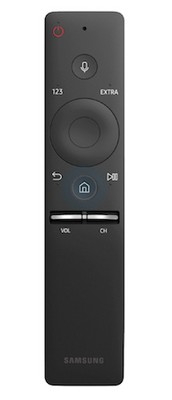
Peak brightness increased noticeably, black depth and black uniformity improved slightly.
Instead of 48 inches, Samsung switched to 49 in 2016.
For comparison, the price of a 2016 Samsung 55KS7500 curved SUHD TV on the Yandex market starts at 117,000.
The cost of last year's analogue, 55JS8500 - from 97,000 (from 3-d).
Interestingly, the price of the flat 55KS7000, which should be the ideal value for money option, while starting at 160,000 (in 5-star stores) is too few offers. In less “stellar” places, the price tag starts at 105,000.
2016-09-21T10:11:47+00:00
MediaGuide
The race to improve TV picture quality continues. Most recently, Samsung's new SUHD TVs went on sale. The last three letters in this abbreviation mean "ultra high definition", but what about the first? Of course, the simplest explanation is Super. But Samsung explains that S symbolizes several concepts at once:
- Spectacular: breathtaking
- Smart: smart
- Stylish: stylish
- superb: luxurious
But these are all words - let's take a closer look at the high technologies that are embodied in this TV.
Quantum dot technology
TVs usually use the RGB color model: red, green and blue. The quality of the picture depends on the purity of the color. Natural hues require a source of pure white light to act as a canvas for other colors.
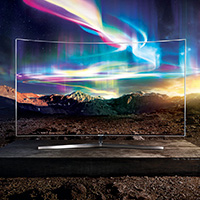
How it works?
In conventional TVs, white light is produced by blue LEDs with a yellow phosphor coating. But such white is far from ideal. SUHD TV uses quantum dots - tiny particles that emit their own light under the influence of a blue diode. In SUHD TV, they provide the purest white light needed for accurate and vibrant color reproduction. The color of quantum dots depends on their size. Blue emit small dots, red - larger dots. However, even large dots are incredibly small. Quantum dot technology and a 10-bit matrix provide 64 times more color combinations than a conventional TV. In other words, this is a billion color shades that allow you to clearly convey any image.

Best Image
The most natural color reproduction due to the use of quantum dot technology is one of the main "chips" of the new line of Samsung SUHD TVs. Quantum dot technology is now considered one of the most promising areas for the development of LCD displays.
Bright white and deep black

In the new TVs, a smart system can analyze each frame and automatically adjust the brightness of different parts of the image in such a way as to convey details as fully as possible without straining your eyes. But this is true for classic formats. Now shooting video in HDR format is gaining popularity. Originally, HDR, or High Dynamic Range, is a shooting technique that helps you get around the limitations of a camera's sensor or film and get a light-balanced photo.
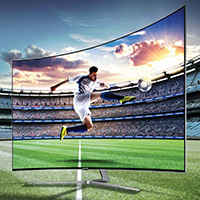
For shooting video in the analog era, HDR was not used - special high-contrast films were used, but they are expensive and have their own problems. In the digital era, it became possible to get a picture on a video the way the human eye sees it. The fact is that the range of brightness between what is considered “black” and what is considered “white” is eight to ten EV stops for modern cameras, and about 12–14 EV for the human eye. That is, what will still contain details for you and me, when shooting without HDR, would turn into black or white spots. But shooting in HDR is not enough - you need to be able to display such content. Samsung's new SUHD TVs have support for HDR 1000 (up to 1000 nits of peak brightness, far exceeding the regular TVs) and are able to transmit the picture as you would see it in person, if you were at the scene. Bright areas look much brighter, dark areas look much darker, which makes the picture incredibly realistic.
Black is black!
Glossy displays are crisper than matte ones, that's a fact, but they often glare. Samsung solved the problem in an interesting way - I saw a "hint" in the creations of Mother Nature. In night moths, the eyes are covered with a tiny network of tubercles, which reduces the reflection of light from the eyes and protects against predators. Samsung engineers have replicated and improved this feature by creating special ordered nanostructures on the surface of the display.
These structures catch the "incoming" rays from the viewer, reflect them at an angle and extinguish them inside the adjacent structure. The rays passing from the back side go further almost unhindered, for them the structure is flat. So you get both a clear picture and no glare on the display surface - even in a brightly lit room, every detail will be clearly visible on the screen.
home life center

Often, for the popularity of the device with the user, you need to meet only two conditions: convenience and stylish look. With this, the Samsung SUHD-series is doing great. The absence of a frame, which usually acts as the border of the image, allows the viewer to be completely immersed in what is happening on the screen. The Smart TV feature has received a number of improvements in 2016 Samsung SUHD TVs: easier menu navigation and content search, a universal One Remote, the ability to play games without connecting a console, and wireless transmission Images.
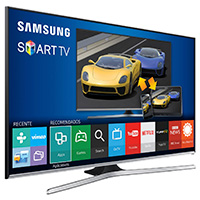
Advanced Menu
Improved Samsung Smart Hub, built on the Tizen OS, is an intuitive interface for finding the content you need. Samsung's new line of SUHD TVs offer convenient wireless media streaming with Smart View. It allows you to stream content (photos, videos or music) from your smartphone or tablet directly to your TV screen.

No additional settings
The HDMI auto-detection feature is also a handy find. Simply connect your device (be it a console, digital tuner or Blu-ray player) to the HDMI socket and the TV will automatically detect the type of connected equipment by displaying the appropriate icon in the menu.

Universal remote control
Universal remote remote control Samsung One Remote is characterized by simplicity and ease of operation. This single remote allows you to control all HDMI devices connected to your TV. So now you can forget about the many push-button remotes to interact with the equipment connected to your TV.

From this year everyone Samsung users SUHD TV cloud gaming services are available. If you're not a hardcore gamer and just like to chill out with some video games sometimes, a standalone console doesn't make much sense anymore. With your new TV, you get access to over 50 modern AAA games. All you need to start playing is a gamepad and an internet connection.
Which diagonal is better?

More doesn't mean better. Of course, I would always like to have something more: a car, an apartment, a TV - but in this case The diagonal should be chosen based on three factors.
- Distance from sofa / chair / armchair / dining table to the display itself
- Display resolution
- Budget

Optimal distance to TV
So what is the best distance to watch TV? The international standardization organization ITU-R recommends viewing a 50-inch TV screen from a distance of two to three meters. If your sofa or chair is less than two meters away, then you'd better get a smaller FHD TV or replace it with a UHD TV or you'll feel uncomfortable. You can watch the image on a 50-inch UHD TV even at a distance of one meter and not feel any discomfort!
While a Full HD TV screen is 1920 x 1080 pixels, a UHD TV screen is 3840 x 2160 pixels, resulting in stunning image clarity. In this way, you can enjoy the viewing experience on a larger UHD TV screen than a Full HD TV without noticing image structure, which is more comfortable for your eyesight.

Samsung's new SUHD TVs range in size from 49 to 88 inches. The launch series of Samsung KS7000 SUHD TVs includes models with a flat screen in three diagonals - 49, 55 and 60 inches. Devices of the next series - Samsung KS7500 - have a curved screen with a diagonal of 49, 55 or 65 inches. In the older series - KS8000 - there are flat-screen TVs in four diagonals: 49, 55, 65 and 75 inches.
The Samsung KS9000 flagship line of SUHD TVs is represented by TVs with curved screen in four diagonals (49, 55, 65 and 78 inches), and the top model 88KS9800 will get a diagonal of 88 inches.
Since all Samsung SUHD TVs have UHD resolution, the image will look great from any distance of one meter. Adjusted for resolution, they are suitable for installation everywhere: both in a large kitchen and in a cozy bedroom.
Featuring a quantum dot display, HDR1000 technology, enhanced Samsung Smart Hub and One Remote, the 2016 SUHD TV line-up is how Samsung sees the future. Simply put, this is a full-fledged OS, synchronization with mobile devices, user-demanded content, high color fidelity, controllable lighting and, of course, ease of control with universal remote control. Samsung is making tomorrow's technology a reality today.
Images: Manufacturing companies
Samsung, the global TV market leader, has unveiled an impressive new line of SUHD TVs. 2016 Samsung SUHD TVs offer unparalleled picture quality with Quantum Dot Displays, the world's first edge-to-edge curved design, and easy access control. entertainment content. In addition, the entire line of SUHD TVs in 2016 supports IoT technologies, which allows the TV to become a smart home hub.
"IN latest models 2016 TVs from Samsung will not feature 3D functionality. We made this decision based on limited consumer demand for 3D and the small amount of content being produced in this format. Instead, we are investing in the production of TVs with a new type of display (Quantum Dot Display) ... SUHD TVs of 2016 are primarily innovations in best quality images, which is very important to consumers,” said Hyun-suk Kim, head of Visual Display Business at Samsung Electronics. "This year, we're going beyond everything we've created before to bring you the epitome of brilliant design and high technology."
Unsurpassed picture quality of Samsung SUHD TVs with Quantum Dot Displays
Samsung's 2016 SUHD TVs feature the world's only cadmium-free 10-bit quantum dot display that delivers the most natural picture quality with stunning brightness, contrast and exceptionally true-to-life colors.
The 2016 models guarantee an optimal viewing experience regardless of the lighting. They are capable of delivering High Dynamic Range (HDR) with a minimum of 1000 nits to enhance the contrast between light and dark images. The new UltraBlack technology dramatically reduces glare and reflections for improved picture quality.
Single access and remote control
Built on the Tizen operating system, Samsung SmartTV2016 TVs provide users with simplified access to content and services - now everything is in one place.
SmartHub 2016 makes accessing the content you need easy and convenient. Online TV, OTT (overthetop - sources of content other than TV), games - Samsung SmartTV allows you to access your favorite programs from the moment you turn on the TV.
New Samsung SmartTVs eliminate the need for multiple remote controls. Samsung smart TVs automatically detect the type of router, game console, OTT device, or home theater device that is connected to the TV. Via Samsung features smart control users can control all devices without additional settings.
Users now have the most realistic gaming experience on big screen without having to purchase a console. Over 500 online and downloadable games will be available for 2016 Samsung SmartTVs. The latest PlayStationTM additions include Assassin's Creed III, Batman: Arkham Origins, The LEGO Movie and more.
Smartview app. The updated app allows users to share their favorite content with their families. SmartView is available for Samsung Galaxy, Android and iOS devices and also for Windows PC. Popular apps and websites including AccuWeather, Crackle, iHeartRadio, M-GO, Plex, Pluto.TV, UFC, Vimeo, YuppTV and more will let users enjoy their favorite apps and services.
Watching UHD movies and TV programs from providers such as Amazon, M-GO or Netflix, as well as accessing YouTube content and online programs Dish and Time Warner Cable has become much more convenient. UHD technologies developed by Neu Lion allow you to include sports programs via UHD live. Users can optionally connect Samsung's new Ultra HD Blu-ray player via HDMI (2.0a) to access HDR UHD movies.
TV becomes the hub of the smart home
All 2016 SUHD TVs embody the future of the Internet of Things and the Samsung Smart Things open platform. SUHD TVs connect and control over 200 compatible SmartThings. Now the TV allows you to see who rings the doorbell, lock all the locks or turn off the lights.
Ultra HD Premium
The UHD Alliance presented at the Consumer Electronics Show (CES) in 2016 the requirements for devices that must meet the "Ultra HD Premium" standard. What should be in the specifications of devices that meet Ultra HD Premium?
Here are some Ultra HD Premium requirements:
- Minimum resolution 3840 x 2160. This parameter is the easiest to understand, since it is just a resolution - the number of pixels that form a television picture - an image on a 4K / Ultra HD TV screen. There can be no confusion in this area.
- 10-bit color depth. This means that the TV must be able to receive and process a 10-bit color signal, and this parameter indicates the number of colors that form this signal. For example, Blu-ray discs use an 8-bit color signal consisting of over 16 million individual colors.
Often referred to as "deep color", a 10-bit color signal consists of over a billion colors and shades. This does not mean that the TV must display all these colors - but it must be able to process this signal. Most decent models are capable of doing this, so there shouldn't be any problems here. - Minimum 90% P3 colors. P3 is what is known as "color space", a standard that defines color information in a video stream. The function of the color space is to ensure that the picture is displayed correctly on the screen installed in your home. Think of a color space as a language of color—a language that follows the same rules as English or any other spoken language.
To qualify as Ultra HD Premium, a TV must be capable of displaying 90% of the colors defined by the P3 color space. This number is usually called the color gamut - those sets of colors that the display is capable of displaying in practice. So a TV that is capable of displaying "90% of P3 colors", in simple terms, displays 90% of the entire color gamut.
The higher the number, the more saturated and accurate the digital palette looks on the TV screen. - Minimum dynamic range. In order to determine if a TV complies with the standard, it is necessary to check its conformity minimum requirements, which regulates the maximum and minimum brightness level that it can display.
There are two different standards:- Option 1: More than 1,000 nits of peak brightness and less than 0.05 nits of black level.
- Option 2: More than 450 nits of peak brightness and less than 0.0005 nits of black level.
The two standards are designed to take advantage of the strengths and weaknesses of the various technologies used to build televisions. Light-emitting diode (LED) televisions, which are the majority of models sold today, support a higher level of maximum brightness, but lag behind in black levels. At the same time, organic light-emitting diode (OLED) TVs are capable of producing incredibly deep blacks. At the same time, these models are inferior in terms of the maximum brightness of the screen.
Panel VA LED
Vertical Alignment (VA) technology was first used by Fujitsu back in 1996 as a compromise between TN and IPS. Compared to TN, VA panels allow the user to be further away from the center of the screen in order to see color shifts. VA-panels practically do not lag behind TN-analogs in response time, but significantly surpass them in depth and color accuracy. At the same time, the minus of VA-panels is, firstly, in the disappearance of details in the shadows when looking at the screen perpendicularly, and secondly, in the noticeable dependence of the color balance of the “picture” on the angle of view.
An improved version of VA panels S-PVA (Super Pattern Vertical Alignment) is now widely used by Sony and Samsung. S-PVAs feature wider viewing angles and deeper blacks. Both companies frequently state that their S-PVA TVs have 178-degree viewing angles horizontally and vertically, and these panels are on par with their IPS counterparts in this respect. Sharp also produces its version of VA panels - Axially Symmetric Vertical Alignment - with similar technical and consumer characteristics.
Samsung TVs 2016 with SUHD support
| KS9800 | KS9500 | KS9000 | KS8000 | KS7500 | KS7000 | |
|---|---|---|---|---|---|---|
| 4K support | eat | eat | eat | eat | eat | eat |
| eat | eat | eat | eat | eat | eat | |
| eat | eat | eat | eat | eat | eat | |
| Local dimming technology | eat | eat | ||||
| 10-bit color depth | eat | eat | eat | eat | eat | eat |
| Tizen operating system | eat | eat | eat | eat | eat | eat |
| Two tuners | eat | eat | eat | eat | ||
| Panel type | VA LCD | VA LCD | VA LCD | VA LCD | VA LCD | VA LCD |
| Peak Illuminator Technology | Ultimate | Ultimate | Pro | Pro | Pro | Pro |
| CPU | Quad | Quad | Quad | Quad | Quad | Quad |
| remote control | Multi | Multi | Multi | Multi | Multi | Multi |
| Backlight type | FALD (Full-array local dimming) | Edge LED | Edge LED | Edge LED | Edge LED | |
| Panel design | curved | curved | curved | flat | curved | flat |
| WiFi | yes (802.11ac) | yes (802.11ac) | yes (802.11ac) | yes (802.11ac) | yes (802.11ac) | yes (802.11ac) |
| 2700 | 2700 | 2400 | 2300 | 2200 | 2100 | |
| VESA support | 400x400 | 400x400 | 400x400 | 400x400 | 400x400 | 400x400 |
| DCI-P3 (P3 color space) | 96% | 96% | 96% | 96% | 96% | 96% |
| Diagonal | 88" | 55", 65", 78" | 49", 55", 65", 78" | 49", 55", 65", 75" | 43", 49", 55", 65" | 49", 55", 60", 65" |
| Sound output power | 70 W | 60 W | 60 W | 60 W | 40 W | 40 W |
Samsung TVs 2016 with UHD and HD support
| KU6670 | KU6500 | KU6400 | KU6170 | KU6070 | KU6300 | K5500 | K5100 | |
|---|---|---|---|---|---|---|---|---|
| Panel design | curved | curved | flat | curved | flat | curved | flat | flat |
| 4K support | eat | eat | eat | eat | eat | No | No | No |
| HDR (high dynamic range) | eat | eat | eat | eat | eat | |||
| UHD Premium compliant | No | No | No | No | No | No | No | No |
| Backlight type | Edge LED | Edge LED | Edge LED | - | - | - | - | - |
| PQI (Picture Quality Index) | 1600 | 1600 | 1500 | 1400 | 1300 | - | - | - |
| 8-bit color depth | eat | eat | eat | eat | eat | eat | eat | eat |
| Panel type | VA LCD | VA LCD | VA LCD | VA LCD | VA LCD | VA LCD | VA LCD | VA LCD |
| Tizen operating system | eat | eat | eat | eat | eat | eat | eat | eat |
| Two tuners | ||||||||
| remote control | Multi | Multi | Multi | standard | standard | standard | standard | standard |
| Sound output power | 20 W | 20 W | 20 W | 20 W | 20 W | 20 W | 20 W | 20 W |
| WiFi | yes (802.11ac) | yes (802.11ac) | yes (802.11ac) | yes (802.11n) | yes (802.11n) | yes (802.11n) | yes (802.11n) | yes (802.11n) |
| VESA support | 400x400 | 400x400 | 400x400 | 400x400 | 400x400 | 400x400 | 400x400 | 400x400 |
| Diagonal | 43", 49", 55", 65" | 43", 49", 55", 65", 78" | 40", 49", 55" | 40", 49", 55", 65" | 40", 43", 50", 55", 60", 65", 70" | 40", 49", 55" | 32", 40", 49", 55" | 32", 40", 49", 55" |
This year, as in the past, there are no devices with OLED displays among the models. According to the company, they want to return to the OLED TV market, but for today these are only plans, and Samsung is promoting its advanced TVs under the SUHD brand.
SUHD TVs were introduced last year. This name does not mean anything specific, but in order to somehow characterize them, we can say that SUHD is something like: LCD + 4K + HDR + quantum dots.
Samsung has made several improvements to its flagship models since 2015. First of all, there is now a "UHD Premium" certificate. Such certificates are awarded by the UHD Alliance, which was created with the assistance of Samsung. With the help of the alliance and these certificates, Samsung intended to fight OLED screens making their SUHD LED screens look better. But two contrast specifications were created separately for LCD screens and for OLED. Therefore, now in the marketing struggle, Samsung will focus on peak brightness. And indeed the peak brightness in SUHD is higher, thanks to the use of Peak Illuminator technology.
Samsung also claims that its models SUHD have a wider color gamut and achieve 96% DCI-P3 (due to quantum dot backlighting). Also, unlike 2015, some SUHD models will have a flat screen, which should please many users. The most expensive flagship models will still come with curved screens, but Samsung is reducing the presence of curved displays in TV models.
Another improvement is the use of "Moth Eye" for the anti-glare filter. This technology should noticeably reduce reflections on the screen's glossy panel.
The flagship model in Europe will be called KS9500, and for the US market it will be called KS9800. This best model this year and successor last year's model JS9500. Here, a full array of LEDs with a local dimming system for HDR (high dynamic range) will be used in the backlight.
HDR - high dynamic range allows you to display high-contrast scenes on the screen. This will be one of the main features of this year's SUHD models.
But this technology will be able to fully realize itself only if there is appropriate HDR content. And this is either UHD Blu-ray players or streaming video. Otherwise, you will not be able to unleash the full potential of the new flagship SUHD TV with HDR, and you will not notice the difference with the younger series.
Now more about HEVC decoder support. This decoder is not a novelty; last year it was part of television receivers. It is the successor to the MPEG4 codec and is used for 4K and HDR video compression for discs as well as streaming video. But Google wants to use its VP9 decoder for the same purpose, which works for 4K videos from YouTube. And for streaming video from YouTube in HDR quality, VP9-PROFILE2 will be introduced in 2016. Samsung says flagship models will support the VP9-PROFILE2 decoder.
Another feature of Samsung's 2016 TV lineup will be the ditching of 3D surround television.
None of this year's models support 3D. Samsung is phasing out this video format entirely.
As for the functionality of Smart TV, Samsung continues to develop it on the Tizen operating system, otherwise Smart Hub. Samsung refuses Google's offer to roll out to TVs Android systems TV, as Philips and Sony did. Coming out this year the second version of the Tizen 2.0 system.
In 2016, Tizen learned how to control a smart home through the SmartThings platform. Anything that can be connected to unified system at home from lamps to doors can be controlled via TV. So even turning on the “cinema” mode on the TV, the lights from the lamps in the house are dimmed and the receiver of the audio system is turned on.
Will not be released this year new block Evolution Kit as promised by Samsung earlier. After all, it was promised that smart TV will be updated every year through the new Evolution Kit. Maybe this means leaving the Evolution Kit?
When choosing the best option for yourself, you can simplify the search among the models. After all, Samsung has a large number of TV models and it can be difficult to understand all the characteristics. For example, you can argue like this: all 6 series TVs are more or less technically identical, only the difference is in design and in a few other minor technical parameters. So choose a series of models for yourself by price and characteristics, and then look at the available models within the series. Recall that the older series 9 is the most advanced and expensive, and the youngest is series 4 with the simplest parameters and at an affordable price.
Samsung's 2016 TV models will start shipping in the spring and all models should be out by the fall.
Samsung TV models of 2016
Samsung KS9800
Will be produced for the American market, is the flagship of this year.
Samsung KS9800
Samsung KS9500
KS9500 is this year's flagship for Europe. The backlight consists of a full array of LEDs with local dimming. For Europe, the 88-inch KS9800 model will also be produced in this series. This is the same KS9500 in terms of parameters, only larger and slightly redesigned.
- Screen - curved (Curved);
- VA LCD;
- Backlight - full Direct array with local dimming;
- 4K resolution;
- HDR10;
- Certificate "UHD Premium";
- Peak Illuminator Ultimate (brightness over 1000 nits);
- 10-bit panel;
- TizenOS;
- Quad-core processor;
- Dual tuner;
- One Connect box;
- HEVC;
- VP9-Profile2;
- Sound 60W (70W in 88");
- WiFi.
The composition of the 9500 series of Samsung TVs in 2016:
55" Samsung UE55KS9500
65" Samsung UE65KS9500
78" Samsung UE78KS9500
88" Samsung UE88KS9800

Samsung KS9500
Samsung KS9000
The KS9000 will be available in the US with a flat screen and in Europe with a curved one. This TV uses edge lighting, but the rest of the specifications are similar to older models. However, the Peak Illuminator system is downgraded.
- Screen - Flat (USA), Curved (Europe);
- VA LCD;
- edge LED;
- 4K resolution;
- HDR10;
- Certificate "UHD Premium";
- Color space 96% DCI-P3;
- 10-bit panel;
- TizenOS;
- Quad-core processor;
- Dual tuner;
- One Connect box;
- HEVC;
- VP9-Profile2;
- Sound 60W;
- WiFi.
Composition of the 9000 series:
49" Samsung UE49KS9000 - $2400
55" Samsung UE55KS9000 - $3000
65" Samsung UE65KS9000 - $4200
75" Samsung UE75KS9000

Samsung KS9000
Samsung KS8000
KS8000 is a flat screen model.
- Screen - flat (Flat);
- VA LCD;
- edge LED;
- 4K resolution;
- HDR10;
- Certificate "UHD Premium";
- Color space 96% DCI-P3;
- Peak Illuminator Pro (brightness over 1000 nits);
- 10-bit panel;
- TizenOS;
- Quad-core processor;
- Dual tuner;
- One Connect box;
- HEVC;
- Sound 60W;
- WiFi.
The composition of the 8000 series and approximate prices:
49" Samsung UE49KS8000 - $2100
55" Samsung UE55KS8000 - $2700
65" Samsung UE65KS8000 - $3800
75" Samsung UE75KS8000 - $6400

Samsung KS8000
Samsung KS7500
The KS7500 series will only be available in Europe. These are curved screen TVs. In terms of parameters, this series is similar to the KS9000. The main difference between the KS9000 and KS7500 is that the latter does not have a dual tuner and the speaker system is less powerful. The speaker power of the KS7500 models is 40W.
The composition of the 7500 series and approximate prices:
43" Samsung UE43KS7500 - $1600
49" Samsung UE49KS7500 - $2000
55" Samsung UE55KS7500 - $2400
65" Samsung UE65KS7500 - $3550
Samsung KS7000
The KS7000 series will also be produced only for Europe. These will be the cheapest SUHD TVs of the year. This series has a flat screen. Turns out in 2016 Samsung introduces completely two series of SUHD flat screen models, while last year there was only one SUHD flat screen model.
The difference between the KS7000 series and the KS8000 is the redesigned design, the absence of a dual tuner and reduced speaker power. The KS8000 is 60W while the KS7000 is 70W. Otherwise, the technical parameters are identical.
The composition of the 7000 series and approximate prices:
49" Samsung UE49KS7000 - $1850
55" Samsung UE55KS7000 - $2130
60" Samsung UE60KS7000 - $2550
65" Samsung UE65KS7000

Samsung KS7000
Samsung KU66xx
We are starting to look at the sixth series of Samsung TVs from the 2016 model range. There is no longer the "SUHD" branding, but there is still 4K Ultra HD resolution. Samsung also offers HDR in this series, but you need to remember that not a single model of the 6 series is equipped for HDR playback, although it is in the description of "HDR processing". These TVs will accept HDR content but will not be able to play it in HDR quality.
- Screen - curved (Curves);
- VA LCD;
- edge LED;
- 4K resolution;
- HDR processing;
- Tizen;
- HEVC;
- Sound 20W;
- WiFi.
Composition of the 66xx series:
43" Samsung UE43KU6670
49" Samsung UE49KU6670
55" Samsung UE55KU6670
65" Samsung UE65KU6680
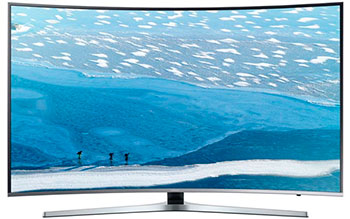
Samsung KU66xx
Samsung KU65xx
The KU65xx models are another 6 series, all models of the sixth series are similar in technical capabilities and differ in some functionality and design. Here, too, the main parameters of the KU65xx coincide with those of the KU66xx.
Composition of the 65xx series:
43" Samsung UE43KU6500
49" Samsung UE49KU6500
55" Samsung UE55KU6500
65" Samsung UE65KU6500
78" Samsung UE78KU6500

Samsung KU65xx
Samsung KU64xx
Another version of the 6 Series - this time with a flat screen. Since the screen is flat, the price should be lower than that of models with a curved screen from previous series. The rest of the specifications are the same as the KU65xx series.
Composition of the KU 64xx series:
40" Samsung UE40KU6400
43" Samsung UE43KU6400
49" Samsung UE49KU6400
55" Samsung UE55KU6400
65" Samsung UE65KU6400
Samsung KU61xx
KU61 are representatives of the 6th series and with a curved screen. The difference from other models of the sixth series is a regular remote control, unlike the multi remote control for older models, and also a Wi-Fi module of a different standard (n) and works slower than previous models where WiFi standard ac.
- Screen - curved (Curved);
- VA LCD;
- edge LED;
- 4K resolution;
- HDR processing;
- Tizen;
- HEVC;
- Sound 20W;
- WiFi (n).
Composition of the KU61xx series:
40" Samsung UE40KU6170
49" Samsung UE49KU6170
55" Samsung UE55KU6170
65" Samsung UE65KU6170
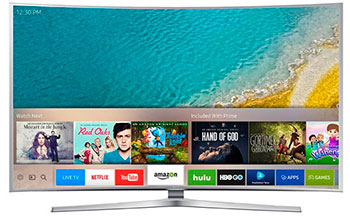
Samsung KU61xx
Samsung KU60xx
Models from the KU60xx series will be Samsung's cheapest 4K models in 2016. These are models with a flat screen, the display diagonal will be up to 70 inches.
- The screen is flat;
- VA LCD;
- 4K resolution;
- HDR processing;
- Tizen;
- HEVC;
- Sound 20W;
- WiFi (n).
Composition of the KU60xx series:
40" Samsung UE40KU6070
43" Samsung UE43KU6070
50" Samsung UE50KU6070
55" Samsung UE55KU6070
60" Samsung UE60KU6070
65" Samsung UE65KU6070
70" Samsung UE70KU6070

Samsung KU60xx
Samsung K63xx
Samsung will sell one HD resolution sub-series in Series 6. The K63 is a curved TV with operating system Tizen.
- The screen is curved;
- VA LCD;
- HD resolution;
- Tizen;
- Sound 20W;
- Standard remote control bullets;
- WiFi (n).
Composition of the K63xx series:
40" Samsung UE40K6300
49" Samsung UE49K6300
55" Samsung UE55K6300
Samsung K5xxx
The 5 Series TVs are the entry-level models in model range 2016. They will be the cheapest and simplest in functionality.
- The screen is flat;
- VA LCD;
- HD resolution;
- Tizen (K55xx only);
- Sound 20W;
- Standard remote control;
- Wi-Fi (n) (K55xx only).
The composition of the 5th series:
32" Samsung UE32K5100
40" Samsung UE40K5100
49" Samsung UE49K5100
55" Samsung UE55K5100
32" Samsung UE32K5500
40" Samsung UE40K5500
49" Samsung UE49K5500
55" Samsung UE55K5500

